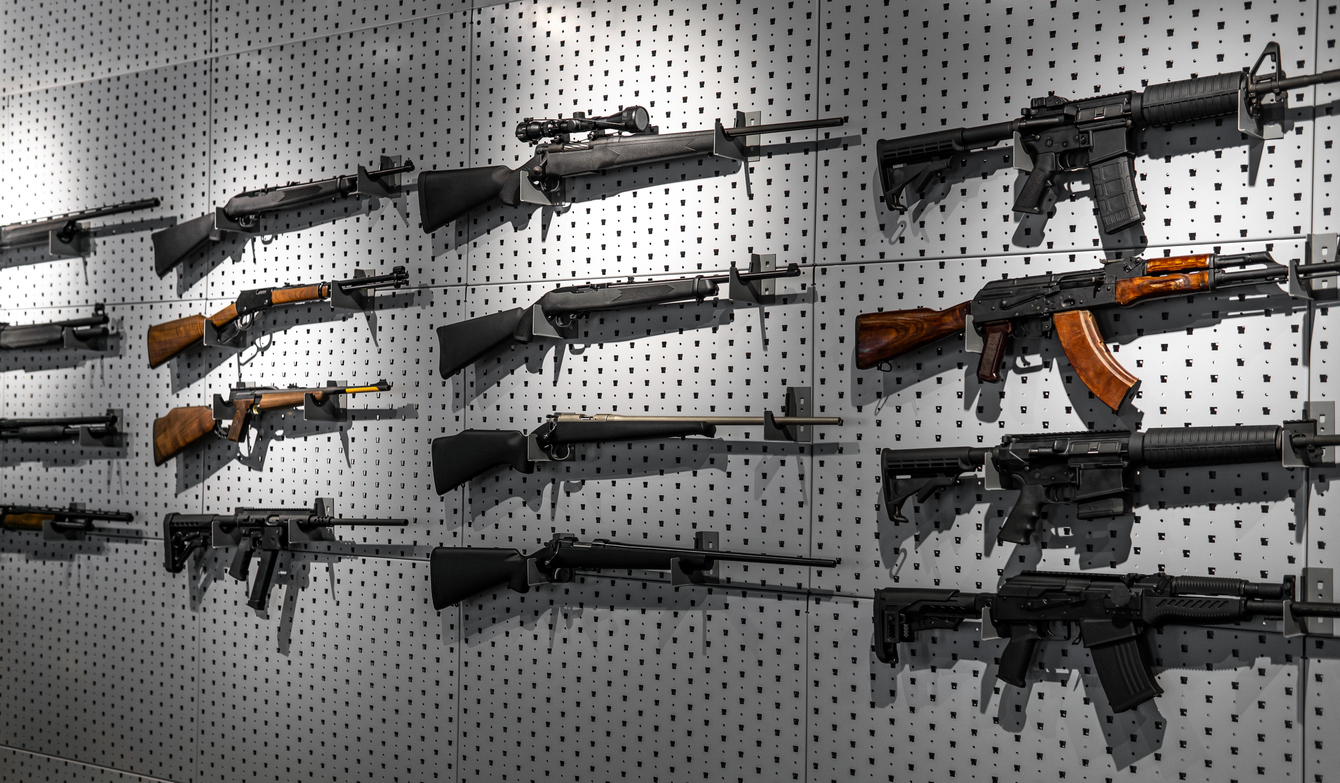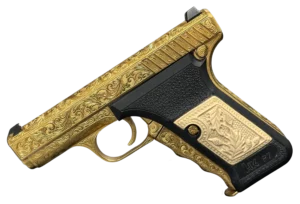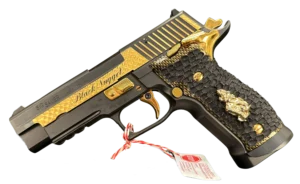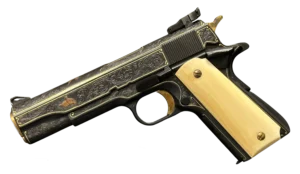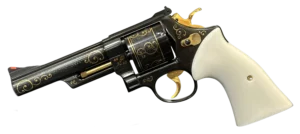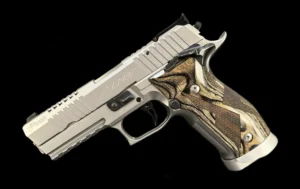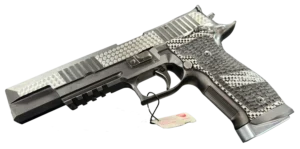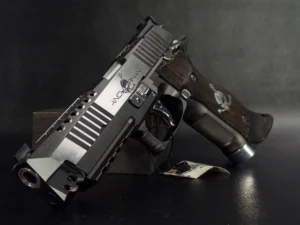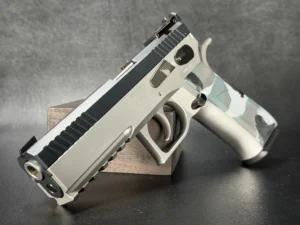Key Takeaways:
- Environment Control Isn’t Rocket Science, But It’s Critical: You don’t need a lab-grade setup to protect your collection—just consistent humidity around 40-50%, stable temperatures, and UV protection. I learned this after watching a gorgeous Winchester fade from window light. Start with a decent hygrometer and some silica gel packets, then gradually build up your environmental controls as needed. The key is preventing sudden changes rather than achieving perfect conditions.
- Museum-Safe Materials Actually Matter (And They’re Not That Expensive): That new-foam smell? It’s off-gassing chemicals that can corrode your firearms over time. I found this out the hard way when cheap foam left corrosion spots on a revolver. Switching to archival-quality, non-off-gassing materials costs more upfront but saves your collection in the long term. Look for “conservation grade” labels—your guns will thank you in twenty years.
- Security and Display Can Actually Work Together: The biggest mistake people make is thinking they have to choose between showing off their collection and keeping it secure. With layered security—locked cases, locked rooms, alarm systems, and clever placement away from windows—you can have both. Biometric locks have become increasingly reliable lately, and most criminals prefer to target easier targets anyway. If your setup appears to be time-consuming and prone to triggering alarms, they will likely move on to someone else’s task.
You know what gets me? Walking into someone’s house and seeing a beautiful collection of firearms just… stuffed into a basic gun safe. Don’t get me wrong—security matters, and I’m not knocking anyone for keeping their guns locked up. But there’s something to be said for displaying your collection with the respect it deserves.
I’ve been collecting for about fifteen years now, and let me tell you, the way I store and display my firearms has evolved dramatically. What started as a simple metal cabinet in my garage has turned into something that wouldn’t look out of place in a small museum. And honestly? The process of creating that space taught me more about preservation and care than I ever expected.
The Art of Showing Off (Responsibly)
Here’s the thing about firearm display: it’s not just about making your guns look pretty. Though let’s be real, there’s nothing wrong with wanting to show off a well-maintained 1911 or that lever-action rifle your grandfather passed down. But proper display storage is actually a complex dance between aesthetics, preservation, and security.
I learned this the hard way when I first started collecting. I had a gorgeous Winchester Model 94 that I kept on a simple wooden rack near a window. Looked fantastic in the afternoon light streaming in. The problem was that the same light was slowly fading at the finish, and I didn’t realize it until a friend pointed out how much duller it looked compared to when I first got it.
That was my wake-up call. Display isn’t just about looking good; it’s about creating an environment where your firearms can age gracefully, rather than deteriorating.
The whole museum approach started making sense to me when I visited the Cody Firearms Museum in Wyoming a few years back. Walking through those halls, seeing how they’d preserved pieces from the 1800s that still looked incredible, I realized there was something to learn from their methods. These weren’t just guns sitting in cases—they were artifacts being actively preserved for future generations.
The Science Behind the Beauty
Now, I’m not going to pretend I’m some conservation expert, but I’ve picked up a thing or two about what actually damages firearms over time. It’s not always what you’d expect.
Take humidity, for instance. You’d think keeping guns in a bone-dry environment would be perfect, right? Wrong. Too little moisture and wooden stocks start cracking. Too much, and you’re dealing with rust and corrosion on the metal parts. It’s like Goldilocks, everything has to be just right.
I recall speaking with a man at a gun show who’d inherited his father’s collection. Beautiful pieces, but they’d been stored in a basement in Florida for twenty years. The humidity down there had done a number on them. Surface rust on nearly everything, and a couple of the stocks had warped so badly they looked like they’d been through a washing machine.
That conversation stuck with me because it highlighted something important: good intentions aren’t enough. His dad clearly loved those guns and wanted to preserve them, but without understanding the science behind preservation, love alone wasn’t sufficient.
Temperature swings are another silent killer. Metal expands and contracts with temperature changes, and over time, this constant movement can loosen screws, affect the fit of moving parts, and generally wear things down faster than normal use would. It’s why those cheap gun cabinets that sit in unheated garages aren’t doing your collection any favors, even if they keep the guns secure.
And then there’s light. UV rays are fierce on finishes and wooden components. I’ve seen rifles where one side was noticeably faded compared to the other, likely due to their position relative to a window. It’s subtle at first, but over the years, it becomes obvious.
Getting the Environment Right
So how do you actually control all these factors without turning your gun room into a laboratory?
First off, forget about trying to achieve museum-level precision right out of the gate. Even museums didn’t start with perfect environmental controls—they developed them over time as they learned what worked.
For humidity control, I started simple. I got myself a decent digital hygrometer (about $40 online) and started monitoring the conditions in my display area throughout the year. My basement stayed relatively stable, with a humidity level of around 45-50% most of the time, but it would spike up to 70% during particularly humid summer days.
The fix was easier than I expected. A small dehumidifier for the worst days, and some silica gel desiccant packets scattered around inside the display cases for fine-tuning. Nothing fancy, but it kept things in that sweet spot between 40-50% humidity year-round.
Temperature was trickier because I was working with a basement space that got chilly in winter and warm in summer. Insulation helped a lot, but the real game-changer was accepting that some temperature variation was inevitable and designing around it. Instead of fighting the environment, I worked with it.
Here’s something I learned from a museum conservation article I found online: sudden changes are worse than gradual ones. So instead of trying to maintain exactly 68 degrees all the time, I focused on preventing rapid swings. Better insulation, weatherstripping around the door, and keeping the space away from direct HVAC vents made a huge difference.
Light management turned out to be the most straightforward issue to solve, once I understood what I was dealing with. UV-filtering glass exists, and it’s not nearly as expensive as I thought it would be. Most of my display cases now use low-iron glass with UV filtering, which blocks the harmful rays while still letting you see everything clearly.
The trick with lighting is finding that balance between being able to see your collection properly and not beating it up with harsh illumination. I ended up going with LED strips that I can dim, positioned to minimize glare while still showing off the details that make each piece special.
Materials Matter More Than You Think
This is where things get a bit nerdy, but stick with me because it’s important.
You know that new-car smell? That’s off-gassing materials releasing chemicals into the air. Some of those chemicals can react with metal over time, causing corrosion or discoloration. The same thing happens with cheap display materials.
I found this out when I noticed some light corrosion spots on a revolver that had been sitting on a foam insert in one of my cases. Turns out the foam I’d bought was the wrong type; it was releasing sulfur compounds that were reacting with the metal. Not a huge deal in the short term, but over the years, it would have caused real damage.
The solution was switching to archival-quality materials. Sounds fancy, but really it just means foams and fabrics that have been tested to make sure they won’t interact chemically with your firearms. It costs a bit more upfront, but considering what you’re protecting, it’s worth it.
Museum-safe doesn’t mean museum-expensive, though. I’ve found good archival foam online for reasonable prices, and once you buy it, it lasts for years. The key is looking for materials specifically labeled as “off-gassing safe” or “conservation grade.”
For wooden components in your display setup, make sure you’re using hardwoods that have been properly sealed. Certain woods can release acidic compounds over time, which isn’t great for metal preservation. Oak, maple, and walnut are generally safe bets once they’re properly finished.
Display Options: From Simple to Spectacular
Now we get to the fun part, actually showing off your collection.
I started with simple wall-mounted racks because they were cheap and got the guns out of a cramped safe where I could barely see them. Nothing wrong with racks, honestly. They’re practical, they show off the profile of your firearms nicely, and they don’t take up much space.
But as my collection grew and my appreciation for proper preservation developed, I started looking at enclosed display cases. The difference is like comparing a garage to a garage with climate control and security.
Display cabinets give you much better control over the environment around your firearms. You can add desiccants, control lighting, and protect against dust and accidental contact. Plus, let’s be honest, there’s something satisfying about opening a well-made display case and seeing your collection properly presented.
The downside is cost and space. A good display cabinet isn’t cheap, and it takes up more room than a simple rack. But if you’re serious about preservation and presentation, it’s worth considering.
Custom solutions are where things get really interesting. I ended up working with a local woodworker to create a display system that fit my specific collection and space. We incorporated adjustable shelving, integrated lighting, and even some hidden storage for accessories and ammunition.
The custom route isn’t for everyone; it’s definitely more expensive and takes longer to get right. But if you’ve got a specific vision for how you want your collection displayed, or if you’re dealing with unusual space constraints, it might be worth exploring.
Security: The Elephant in the Room
Let’s talk about the thing that keeps most people from displaying their firearms: security.
I get it. The idea of having guns visible, even behind glass, makes some folks nervous. What if someone breaks in? What if they can see exactly what you have? These are legitimate concerns that you need to address before you start planning any kind of display.
The good news is that security and display aren’t mutually exclusive. You can have both if you’re smart about it.
First, location matters. My gun room isn’t visible from any windows, and you can’t see into it from the main living areas of the house. Someone would have to be specifically looking for it to even know it exists.
Second, layered security is your friend. My display cases are locked, the room itself is locked, and the whole setup is tied into the house’s security system. Breaking into one of my display cases would trigger alarms and send alerts to my phone and the monitoring company.
Biometric locks have come a long way in recent years. I use them on my main display cabinet, and they’re fast, reliable, and eliminate the need to keep track of keys or remember combinations. The technology isn’t perfect, nothing is, but it’s good enough for most residential applications.
One thing I learned from a security consultant is that most criminals are looking for easy targets. If your display setup looks like it would take time and effort to break into, and if it’s likely to trigger alarms in the process, most thieves will move on to easier pickings.
That said, I’m not advocating for making your collection visible from the street or advertising what you have on social media. Common sense still applies.
The Long Game: Preservation Over Time
Here’s something they don’t tell you when you start collecting: maintenance never stops.
Even with perfect environmental controls and museum-quality storage, your firearms still need regular attention. The difference is that proper display and storage make maintenance easier and less frequent.
I’ve got a routine now where I inspect each piece in my collection every few months. Just a visual check to make sure everything looks good, no new rust spots, no changes in the wood, no loose screws or other issues developing.
For guns that get handled regularly, this might mean a light cleaning and re-oiling. For display-only pieces, it might just mean a careful dusting with a soft brush. The key is staying ahead of problems before they become serious.
Gun socks are worth mentioning here. They’re basically cloth sleeves that slip over your firearms to provide an extra layer of protection against dust and minor dings. Not necessary if your guns are in enclosed cases, but useful for open displays or less controlled environments.
The oils and preservatives you use matter too. I’ve switched to products specifically designed for long-term storage rather than just cleaning and maintenance. These tend to provide longer-lasting protection and are less likely to attract dirt or gum up over time.
Rotation is something I borrowed from museums. They don’t keep the same artifacts on display all the time—they rotate pieces in and out of storage to minimize wear. I do something similar with my collection, occasionally swapping pieces between display and secure storage to even out exposure to light and handling.
Learning from the Pros
One of the best investments I made was joining a local collectors’ group. The knowledge sharing that happens when you get a bunch of serious collectors together is incredible.
I learned about proper lighting from a guy who used to work in museum exhibit design. Picked up storage tips from someone who’d spent years dealing with corrosion issues in a maritime environment. Got recommendations for conservation supplies from a collector who’d been at this for thirty years.
There are also online communities where people share photos of their setups and discuss what works and what doesn’t. Seeing how others have solved similar problems to yours can save you a lot of trial and error.
Professional conservation resources exist, too, though they’re usually aimed at museums and institutions. Still, a lot of the principles apply to private collections, and you can often find simplified versions of professional techniques that work on a smaller scale.
Common Mistakes (That I’ve Made)
Let me save you some trouble by sharing mistakes I’ve made along the way.
First mistake: trying to do everything at once. When I first got serious about proper display and storage, I wanted to transform my entire setup immediately. This led to rushed decisions, overspending, and some choices I later regretted. Better to start with the basics and build up gradually.
Second mistake: focusing too much on looks and not enough on preservation. My first custom display case was beautiful but had some environmental control issues that I didn’t discover until later. Pretty doesn’t mean proper.
Third mistake: not planning for growth. My collection kept expanding, but my storage solutions didn’t account for this. I ended up having to reconfigure things multiple times as I ran out of space.
Fourth mistake: underestimating the importance of good documentation. I didn’t keep careful records of what was stored where, when pieces were last inspected, or what maintenance had been performed. This came back to bite me when I needed to track down a specific piece or remember when something had last been serviced.
Fifth mistake: getting too caught up in perfection. There’s always going to be something you could do better or some new piece of equipment that might improve your setup. Don’t let the perfect be the enemy of the good.
Real-World Examples
Let me tell you about a few different approaches I’ve seen that work well.
A friend of mine focuses primarily on military surplus rifles. His display is set up chronologically, showing the evolution of infantry weapons from the late 1800s through the mid-1900s. Each piece is mounted at the same height with consistent spacing, and he’s included period-appropriate accessories and documentation. It tells a story, not just displays objects.
Another collector I know specializes in American-made sporting rifles. His setup is more like a high-end gun store display—very clean and modern, with excellent lighting that really shows off the craftsmanship and wood grain on his pieces. Everything is accessible for handling, which matters to him because he actually shoots most of his collection regularly.
Then there’s the guy who inherited a massive collection from his father and grandfather. His approach is more like a traditional museum, with different sections for different types of firearms. He’s got handguns in one area, long guns in another, and a separate section for rare or historically significant pieces. It’s not the most efficient use of space, but it works for the size and diversity of his collection.
Each approach reflects the collector’s priorities and interests. There’s no single “right” way to do this.
The Technology Angle
One area that’s evolved significantly since I started collecting is the technology available for monitoring and controlling your storage environment.
Smart humidity sensors that connect to your phone are now affordable and reliable. You can get alerts if conditions change, track trends over time, and adjust your environmental controls remotely.
Security systems have gotten smarter too. Motion sensors, door contacts, and cameras that integrate with smartphone apps make it easy to keep tabs on your collection even when you’re not home.
LED lighting technology has also improved dramatically. The color rendering is better, they produce less heat, and they last longer than traditional lighting options. Plus, you can get them in different color temperatures to show off your firearms in the most flattering light.
Even something as simple as label makers has gotten better. Being able to create professional-looking labels for your display cases and storage areas helps with organization and gives the whole setup a more finished appearance.
The Social Aspect
Something I didn’t expect when I started taking display and preservation seriously was how much it would enhance the social aspect of collecting.
Having a proper display space makes it much more enjoyable to show your collection to other enthusiasts. Instead of dragging guns out of a safe one by one, you can walk people through your display and actually discuss the pieces in a comfortable environment.
I’ve hosted several small gatherings for members of my collectors’ group, and these events have led to some great discussions about history, craftsmanship, and collecting strategies. There’s something about seeing firearms properly displayed that encourages more thoughtful conversation than just passing them around a kitchen table.
It’s also made me more selective about what I add to my collection. When you’ve got limited display space and you’re committed to showing each piece properly, you think more carefully about whether a potential acquisition really deserves a spot in your setup.
Budget Considerations
Let’s be real about costs because proper display and preservation isn’t free.
You can start simple and build up gradually. A basic hygrometer, some silica gel packets, and better lighting don’t cost much but can make a significant difference in preservation. From there, you can add enclosed cases, better environmental controls, and security features as your budget allows.
I’ve found that buying quality components once is usually cheaper in the long run than buying cheap stuff and having to replace or upgrade it later. But quality doesn’t always mean expensive—sometimes it just means doing your research and buying the right thing for your specific needs.
Consider the value of what you’re protecting, too. If you’ve got thousands of dollars invested in your collection, spending a few hundred on proper storage and display makes financial sense even if you ignore the preservation and enjoyment benefits.
Future-Proofing Your Setup
Think about where your collection might be in five or ten years when you’re designing your display and storage system.
Will you have more pieces? Different types of firearms? A larger space to work with? Building some flexibility into your initial setup can save you major headaches down the road.
Modular systems work well for this. Instead of building one massive custom case, consider multiple smaller units that can be rearranged or added to as your needs change.
Technology integration is worth thinking about, too. Even if you don’t want smart sensors and automated controls right now, running the wiring and leaving space for them might be worth doing while you’re setting things up initially.
Wrapping Up (Sort Of)
Here’s what I’ve learned after years of tinkering with display and storage setups: there’s no finish line. Your collection will change, your space will change, your priorities will change, and your display setup will need to evolve along with them.
The key is getting started with something reasonable and then improving it gradually based on what you learn and what problems you encounter. Don’t let the perfect be the enemy of the good, but also don’t settle for solutions that you know aren’t adequate for the long term.
Your firearms deserve better than being crammed into a basic safe where you can’t see or appreciate them. However, they also deserve better than being put on display in ways that will ultimately harm them. Finding that balance between preservation and presentation is what makes this whole endeavor interesting.
Whether you end up with a simple rack system or a full museum-quality display, the important thing is that you’re thinking about both the immediate enjoyment and the long-term preservation of your collection. These aren’t just objects—they’re pieces of history, examples of craftsmanship, and often family heirlooms that deserve to be passed down in good condition.
Take your time, conduct thorough research, and don’t hesitate to seek assistance from more experienced collectors. Most people in this community are happy to share what they’ve learned, and you’ll probably discover that the process of creating a proper display is almost as rewarding as the end result.
And who knows? You might end up with something so impressive that your friends start asking for tours. Just don’t let them touch the glass with their grubby fingers.
Frequently Asked Questions
Honestly, it depends on what you’re starting with and how fancy you want to get. You can make a real difference for under $200: a decent hygrometer, some UV-filtering glass, silica gel packets, and better lighting. From there, enclosed cases run anywhere from $500 to several thousand, depending on size and features. I always tell people to start simple and build up rather than blow their budget on one perfect case right out of the gate.
This is the question everyone asks, and I get it. The trick is being smart about location and security layers. My gun room isn’t visible from outside, and you’d have to know it exists to find it. Multiple locks, alarms, and making your setup look like more trouble than it’s worth go a long way. Most criminals want easy scores, not to spend twenty minutes trying to break into alarmed display cases.
The sweet spot is usually 40-50% humidity. Too dry and wooden stocks crack, too wet and you get rust issues. I use a digital hygrometer to monitor things and adjust with a small dehumidifier or humidifier as needed. Silica gel packets inside display cases help with fine-tuning. Don’t obsess over hitting exact numbers; consistency matters more than perfection.
Absolutely. I know collectors who display their regular shooters and just do a quick cleaning and inspection when they come back from the range. The key is having easy access to your display setup and not being so precious about it that you’re afraid to handle the guns. Museum-quality doesn’t have to mean museum-only.


